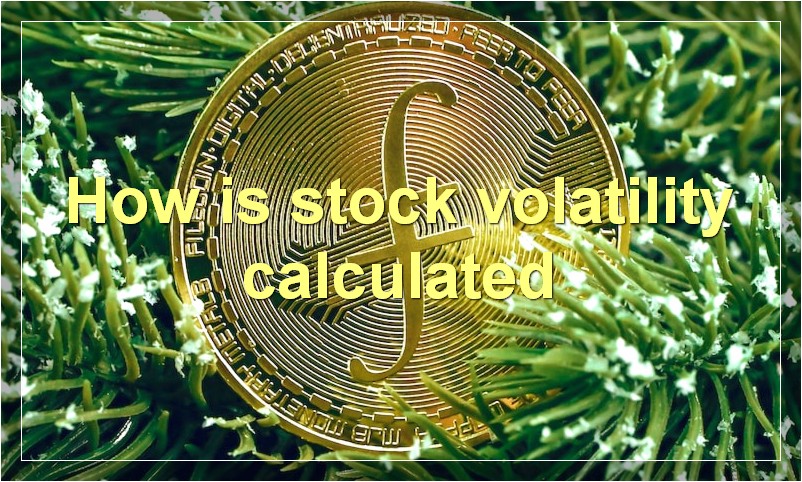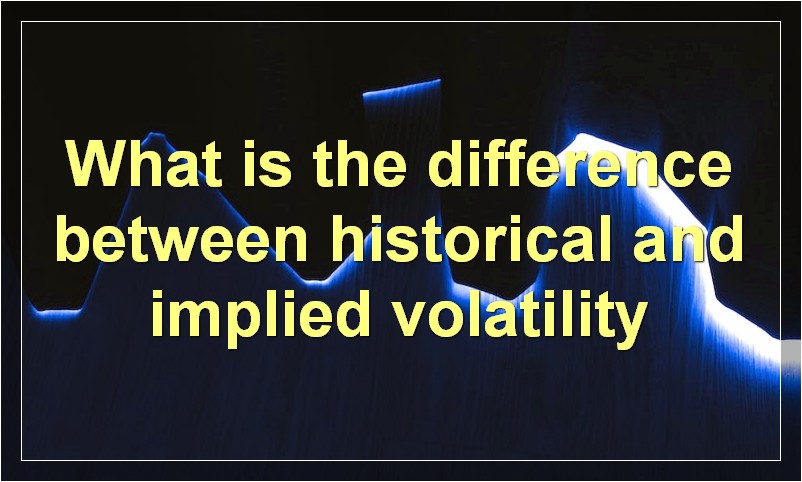The stock market is a volatile place. If you’re thinking about investing, you need to understand the risks.
How is stock volatility calculated

Volatility is a measure of how much the price of a security, such as a stock, fluctuates. It is calculated by taking the standard deviation of the security’s price over a certain period of time, usually 20 or 21 days.
The higher the volatility, the greater the fluctuations in price. A stock with high volatility is considered to be more risky than a stock with low volatility.
What factors affect stock volatility
How do I use a stock volatility calculator
Why is stock volatility important
Stock volatility is important because it affects the price of options. Options are derivative contracts that give the holder the right to buy or sell an underlying asset at a specified price on or before a certain date. The price of an option is made up of two components: the intrinsic value and the time value. The intrinsic value is the difference between the strike price and the current price of the underlying asset. The time value is the amount by which the option’s premium exceeds its intrinsic value and is a function of the length of time until expiration and the volatility of the underlying asset.
Volatility is important because it affects the amount of time value an option has. The higher the volatility, the greater the chance that the underlying asset’s price will move enough to make the option profitable. This means that options with a higher volatility will have a higher premium than those with a lower volatility.
What is the difference between historical and implied volatility

Historical volatility is simply a measure of how much prices in a given market have fluctuated over a certain period of time. Implied volatility, on the other hand, is what options traders use to gauge how volatile a market is expected to be in the future. It’s important to note that implied volatility is forward-looking, while historical volatility is backward-looking.
So, what exactly is implied volatility? In order to understand implied volatility, we need to first understand what an option is. An option is a contract that gives the holder the right, but not the obligation, to buy or sell an asset at a specific price on or before a certain date. The asset in question is typically a stock or commodity.
There are two types of options: call options and put options. A call option gives the holder the right to buy the underlying asset, while a put option gives the holder the right to sell the underlying asset. The price at which the holder can buy or sell the asset is known as the strike price.
The key difference between historical and implied volatility is that historical volatility looks at past price movements while implied volatility looks at future price movements.
How can I find out what the current level of stock volatility is
There are a few ways to find out the current level of stock volatility. The first way is to look at the VIX, which is a measure of implied volatility. The VIX is calculated by taking the weighted average of the prices of put and call options. The VIX is often referred to as the “fear index” because it tends to spike when there is a lot of market uncertainty. A high VIX means that there is a lot of volatility in the markets and a low VIX means that there is less volatility.
Another way to find out the current level of stock volatility is to look at the Beta of a stock. Beta measures how volatile a stock is relative to the overall market. A high Beta means that a stock is more volatile than the market and a low Beta means that a stock is less volatile than the market.
Finally, you can also look at the historical volatility of a stock. Historical volatility measures how much a stock has fluctuated in price over time. A stock with high historical volatility means that it has experienced a lot of price movement over time and a stock with low historical volatility means that it has not experienced much price movement over time.
All of these measures can give you an idea of how volatile the markets are and how volatile a particular stock is.
Is there a relationship between stock prices and volatility
Some investors believe that there is a relationship between stock prices and volatility, but the jury is still out on whether this is truly the case. While some studies have shown a correlation between the two, other research has been inconclusive. Volatility can be a difficult concept to measure, which may account for some of the discrepancy in the findings.
One thing that is certain is that investors tend to react differently to volatile markets. Some get spooked and sell off their holdings, while others see it as an opportunity to buy low and sell high. Volatility can create both Winners and losers in the market, so it’s important to be aware of your own risk tolerance before making any investment decisions.
What are some strategies for managing stock volatility
If you’re like most people, the thought of stock volatility probably makes your stomach churn. After all, who wants to see the value of their investments go up and down like a roller coaster?
Fortunately, there are some strategies you can use to help manage stock volatility and minimize its impact on your portfolio.
One strategy is to diversify your holdings. This means investing in a mix of different types of assets, such as stocks, bonds, and cash. By spreading your money around, you’ll reduce your overall risk and be less likely to experience big losses if one particular investment takes a tumble.
Another approach is to invest in quality companies that have a history of weathering market storms. These “blue chip” stocks tend to be more stable than others and may provide some protection against volatility.
Finally, remember that stock prices go up and down all the time. While it’s natural to feel anxious when the market is volatile, try to stay calm and focus on the long-term. Over time, the market has a tendency to rebound, so hang in there and don’t make any rash decisions.
Can stock volatility be predicted
Stock volatility is a measure of how much the price of a stock fluctuates. It is usually measured by calculating the standard deviation of the daily price changes over a certain period of time. Many factors can affect the volatility of a stock, such as the overall market conditions, the company’s financial condition, and even world events. While it is not always possible to predict stock volatility with 100% accuracy, there are methods that investors can use to try to estimate it. Some common techniques include analyzing past price data, studying analyst reports, and monitoring news headlines.

